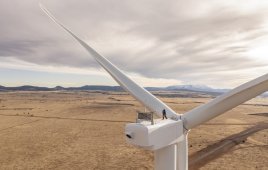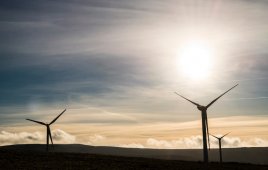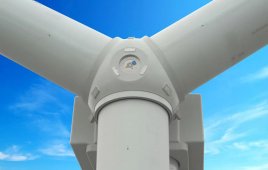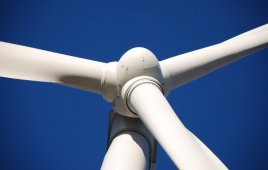There seems no shortage of creative thinking for placing turbines offshore. Take the Hexicon Energy Platform for example. The concept comes from Sweden-based Hexicon AB, (hexicon.eu) and shows the culmination of several clever ideas for generating power from wind and waves. The design is said to reduce service needs and extend its lifespan thanks to a platform equipped with a Fagerdala Hull. It’s a sandwich of dense foam between steel plates that will need no painting, and so provide a longer life of equipment and structure. The firm says the floating platform with this hull can:
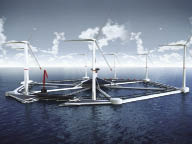
The Hexicon Energy Platform in this configuration will span 360-m across, and larger units are possible. The structure is based on a hull design made of sandwiched materials that provide a formable yet rigid structure. The orange crane to the left runs around the perimeter on rails and is carrying a blade for an unfinished turbine.
• House most of today’s wave, wind, and ocean-current energy generators
• Upgrade easily to more advanced turbines or ideas
• Assemble and be equipped on location
• Require less maintenance than conventional ocean structures
• Be attractive, mobile, and flexible
• Include equipment to manage harsh weather
• Provide a relatively short ROI
The firm says the unit can be constructed in sections, shipped to location or nearby port, and assembled there. The design can be built in many more locations and in deep water that would rule out conventional seabed foundations. A configuration with a 360-m dia., says Hexicon, could have an energy generation capacity of 30 to 60 MW or more depending on development, location, and equipment. The platform is large enough to carry more than wind turbines which will improve its overall power output. For instance, a recent idea is to generate energy from wave and ocean-currents.
The company says comparing the cost/kWh produced to stationary offshore single-mounted units shows a competitive edge. The cost of maintenance, service, turbine repair, gearboxes, and other equipment will be reduced because the hull protects the platform and equipment. The Hexicon platform is large enough to support and carry out work on board with an onboard crane and a crew available 24/7. The crew will be able to perform its duties with little regard to weather and hence will have little need of service ships.

A cross section of the perimeter structure shows how waves would be directed over it and down in a way that captures some of their kinetic energy. The circular center sections, about 8-ft dia., lets crews walk around to service equipment.
An anchoring method lets the platform always face the wind. In case of hurricane-force winds or ice buildup, the platform can be lowered or raised with ballast. This means locations with active ocean currents or tidal currents, such as the Gulfsteam, can also provide a constant source of power.
The platform is said to be large enough to withstand harsh weather and still offer comfortable working and living conditions. Hexicon also claims easier logistics. For instance, mounting or removing turbine blades needs no service ship. Onboard rails guide a mobile crane around the perimeter along with other equipment to handle heavy turbine components. WPE
Filed Under: Turbines


